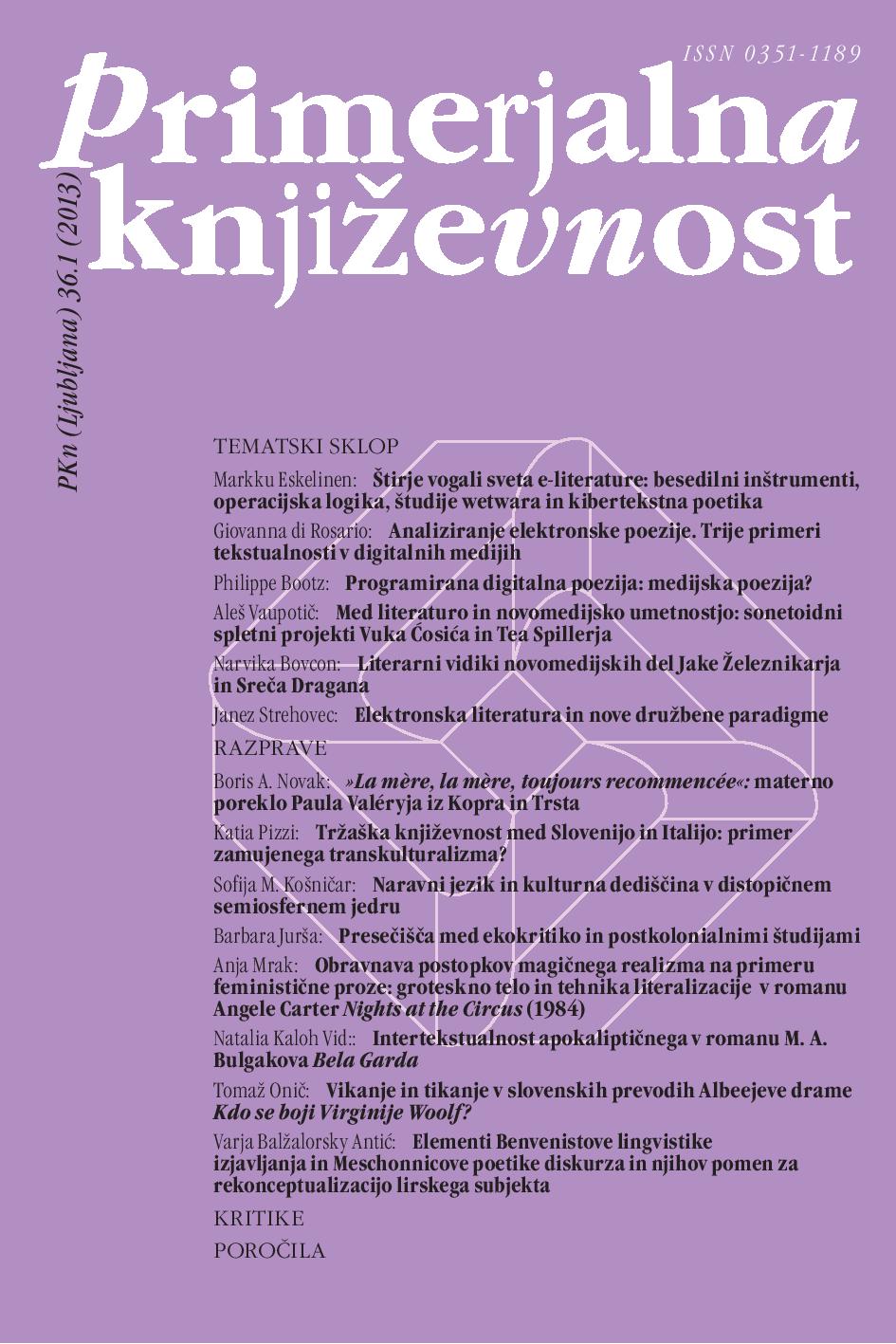The Four Corners of the E-Lit World: Textual Instruments, Operational Logics, Wetware Studies, and Cybertext Poetics
Keywords:
digital literature, electronic poetry, cybertext, textualityAbstract
The paper focuses on the frontiers of electronic literature as exemplified by four different but interconnected research areas: textual instruments, operational logics, cybertext poetics and wetware studies.References
Aarseth, Espen. Cybertext. Perspectives on Ergodic Literature. Baltimore and London: Johns Hopkins University Press, 1997.
Andrews, Jim Arteroids. 2001. Web. 23 Dec 2012 www.vispo.com/arteroids.
Burghardt, Gordon M. The Genesis of Animal Play. Cambridge and London: The MIT Press, 2005.
Cayley, John. “From Byte to Inscription.” The Iowa Web Review (2003). Web. 23 Dec 2012 http://iowareview.uiowa.edu/TIRW/TIRW_Archive/tirweb/feature/cayley/cayley_interview.pdf.
– – –. “riverIsland.” The Iowa Web Review 9.2 (2008). Web. 5 July 2011. http://research-intermedia.art.uiowa.edu/tirw/vol9n2/johncayley.php.
Cortazar, Julio. Hopscotch. New York: Pantheon Books, 1966.
Eskelinen, Markku. Cybertext Poetics. New York and London: Continuum, 2012.
Eskelinen Markku and Raine Koskimaa. “Discourse Timer.” Dichtung Digital. Jun 2001.
Gendolla, Peter and Jörgen Schäfer (eds.). Beyond the Screen. Bielefeld: transcript Verlag, 2010.
Hoffman, Abbie. “Steal This Book.” The Best of Abbie Hoffman. Eds. Daniel Simon and Abbie Hoffman. New York: Four Walls Eight Windows, 1989. 187–339.
Johnson, B. S. The Unfortunates. London: Picador, 2007.
Juul, Jesper. Casual Play. Cambridge and London: The MIT Press, 2010.
– – –. Half-Real. Video Games Between Real Rules and Fictional Worlds. PhD dissertation. Copenhagen: IT-University of Copenhagen, 2004.
Kac, Eduardo. Aromapoetry. 2011. Nanotechnologically modified book.
Milgram, Stanley. Obedience to Authority. An Experimental View. New York: Harper & Row, 1974.
Moulthrop, Stuart. “From Work to Play: Molecular Culture in the Time of Deadly Games.” First Person. New Media as Story, Performance and Game. Ed. Noah Wardrip-Fruin and Pat Harrigan. Cambridge and London: The MIT Press, 2004. 56–69.
– – –. Pax. An Instrument. 2003. Web. 23 Dec 2012. https://pantherfile.uwm.edu/moulthro/hypertexts/pax/.
– – –. “Reagan Library.” 1999. Electronic Literature Collection I. Eds. N. Katherine Hayles, Nick Montfort, Scott Rettberg and Stephanie Strickland. Web. 23 Dec 2012. http://collection.eliterature.org/1/works/moulthrop_reagan_library.html.
Salen, Katie and Eric Zimmerman. Rules of Play. Game Design Fundamentals. Cambridge and London: The MIT Press, 2004.
Saporta, Marc. Composition No. 1. Paris: Seuil, 1962.
Simanowski, Roberto. Digital Art and Meaning. Minneapolis: University of Minnesota Press, 2011.
Sutton-Smith, Brian. The Ambiguity of Play. Cambridge and London: Harvard University Press, 1997.
Wardrip-Fruin, Noah. “Beyond Complex Surfaces.” Beyond the Screen. Eds. Peter Gendolla and Jörgen Schäfer. Bielefeld: transcript Verlag, 2010. 227–248.
– – –. Expressive Processing. Digital Fictions, Computer Games, and Software Studies. Cambridge and London: The MIT Press, 2009.
– – –. “From Instrumental Texts to Textual Instruments.” 2003. Web. 23 Dec 2012. www.hyperfiction.org/talks/dac03.pdf.
Wardrip-Fruin, Noah, David Durand, Brion Moss and Elaine Froehlich. “Regime Change.” 2004. Electronic Literature Collection I. Eds. N. Katherine Hayles, Nick Montfort, Scott Rettberg and Stephanie Strickland. Web. 23 Dec 2012. http://collection.eliterature.org/1/works/wardrip-fruin_durand_moss_froehlich_regime_change.html.
Wardrip-Fruin, Noah et al. Screen. 2004. CAVE work.
Zimbardo, Phillip. The Lucifer Effect. New York: Random House, 2007.


